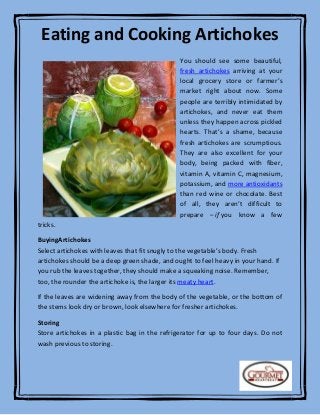
Eating and cooking artichokes
- 1. Eating and Cooking Artichokes You should see some beautiful, fresh artichokes arriving at your local grocery store or farmer’s market right about now. Some people are terribly intimidated by artichokes, and never eat them unless they happen across pickled hearts. That’s a shame, because fresh artichokes are scrumptious. They are also excellent for your body, being packed with fiber, vitamin A, vitamin C, magnesium, potassium, and more antioxidants than red wine or chocolate. Best of all, they aren’t difficult to prepare – if you know a few tricks. BuyingArtichokes Select artichokes with leaves that fit snugly to the vegetable’s body. Fresh artichokes should be a deep green shade, and ought to feel heavy in your hand. If you rub the leaves together, they should make a squeaking noise. Remember, too, the rounder the artichoke is, the larger its meaty heart. If the leaves are widening away from the body of the vegetable, or the bottom of the stems look dry or brown, look elsewhere for fresher artichokes. Storing Store artichokes in a plastic bag in the refrigerator for up to four days. Do not wash previous to storing.
- 2. Preparing Wash the artichokes immediately before cooking, using warm water and a gentle scrubbing motion with your hands. Don’t try to clean between the leaves, or they may break off. Place the artichokes in a bowl of water and fresh lemon juice. Hold each artichoke by its stem and cut all the thorns off the vegetable using a pair of scissors. Using a serrated knife, chop off the top ½ inch of the artichoke. If you like, you may also cut off the stem. This is typically done for stuffed artichokes, because it allows the vegetable to sit flat on a plate. However, artichoke stems are tasty, so you may wish to save them for a soup, stew, or roast. Once one artichoke is prepared, put it back in the lemon water, to prevent browning. Cooking Artichokes lend themselves to many types of cooking, going well with peppercorns, marjoram, parsley, savory, and paprika. Small artichokes are fantastic added to a roast, along with potatoes and other vegetables. They may also be sautéed in a little olive oil. Steamed artichokes are simple and easy to prepare. Place them in a steamer for 25 – 35 minutes, until tender. If you like, mix together 1 cup of melted butter, ½ teaspoon of lemon zest, 1 tablespoon of fresh lemon juice,
- 3. and a little pepper, and serve as a dipping sauce. Some people prefer the simplicity of Ranch dressing or mayonnaise as a dip. Another common method of cooking artichokes is by boiling. For every 4 cups of water added to a large pot, add a tablespoon of salt. Bring to a boil. Add the juice from 1 lemon, plus 5 tablespoons of olive oil. Gently drop the artichokes into the water and simmer for about 20 minutes. Do not overcrowd. To stuff an artichoke, cut ¾ inch from the top, instead of the usual ½ inch. Spread the leaves of the uncooked vegetable and pack it with a stuffing of your choice. Place the stuffed artichokes upright in a steamer until tender. How to Eat Artichokes Artichokes may be eaten hot or cold, but I far prefer them hot. To eat, simply pull off one leaf at a time and (if desired) dip the meaty end (the part that was closest to the body of the vegetable) while holding on to the outer edge of the leaf. Place in your mouth, with the dipped side down, and pull the vegetable through your teeth, removing the meaty part. Discard what’s left of the leaf. Using a spoon or knife, scrape out the fuzzy part covering the artichoke heart. Cut the heart into pieces and eat as is, or dip.
